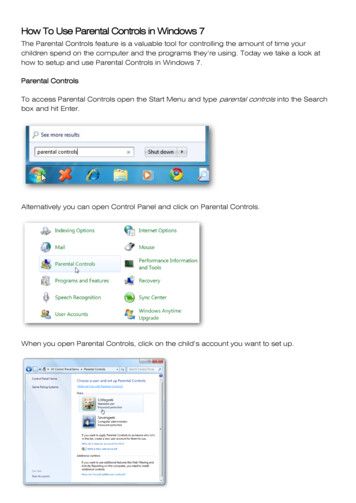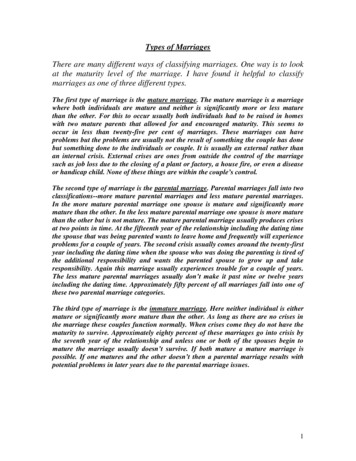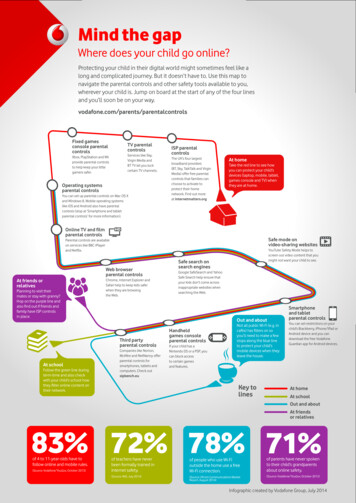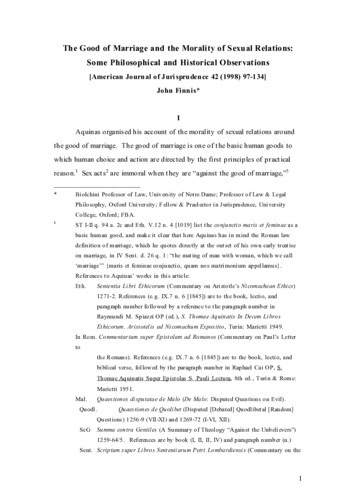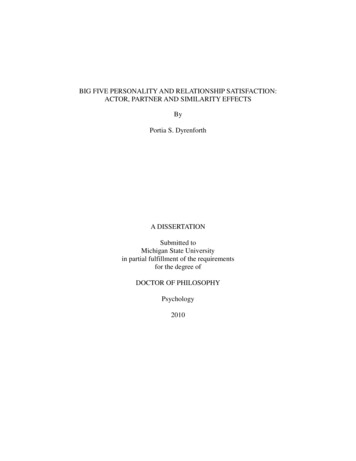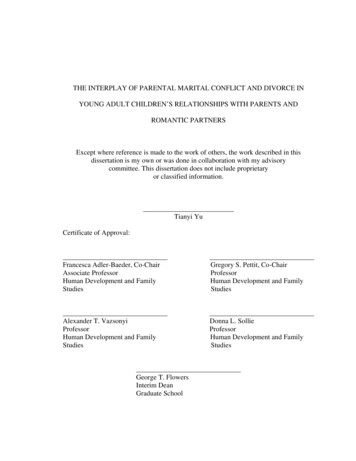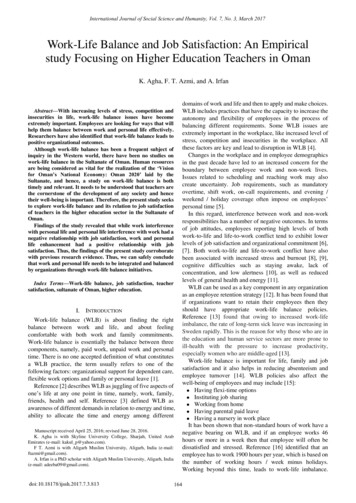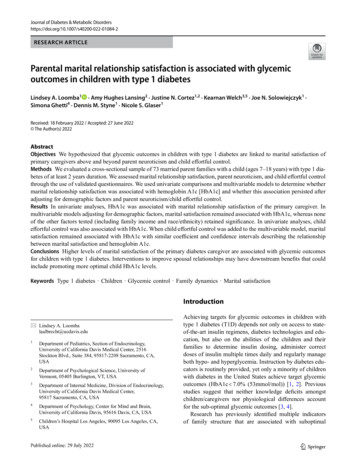
Transcription
Journal of Diabetes & Metabolic 2RESEARCH ARTICLEParental marital relationship satisfaction is associated with glycemicoutcomes in children with type 1 diabetesLindsey A. Loomba1 · Amy Hughes Lansing2 · Justine N. Cortez1,2 · Kearnan Welch3,5 · Joe N. Solowiejczyk1 ·Simona Ghetti4 · Dennis M. Styne1 · Nicole S. Glaser1Received: 18 February 2022 / Accepted: 27 June 2022 The Author(s) 2022AbstractObjectives We hypothesized that glycemic outcomes in children with type 1 diabetes are linked to marital satisfaction ofprimary caregivers above and beyond parent neuroticism and child effortful control.Methods We evaluated a cross-sectional sample of 73 married parent families with a child (ages 7–18 years) with type 1 diabetes of at least 2 years duration. We assessed marital relationship satisfaction, parent neuroticism, and child effortful controlthrough the use of validated questionnaires. We used univariate comparisons and multivariable models to determine whethermarital relationship satisfaction was associated with hemoglobin A1c [HbA1c] and whether this association persisted afteradjusting for demographic factors and parent neuroticism/child effortful control.Results In univariate analyses, HbA1c was associated with marital relationship satisfaction of the primary caregiver. Inmultivariable models adjusting for demographic factors, marital satisfaction remained associated with HbA1c, whereas noneof the other factors tested (including family income and race/ethnicity) retained significance. In univariate analyses, childeffortful control was also associated with HbA1c. When child effortful control was added to the multivariable model, maritalsatisfaction remained associated with HbA1c with similar coefficient and confidence intervals describing the relationshipbetween marital satisfaction and hemoglobin A1c.Conclusions Higher levels of marital satisfaction of the primary diabetes caregiver are associated with glycemic outcomesfor children with type 1 diabetes. Interventions to improve spousal relationships may have downstream benefits that couldinclude promoting more optimal child HbA1c levels.Keywords Type 1 diabetes · Children · Glycemic control · Family dynamics · Marital satisfactionIntroductionLindsey A. Loombalaalbrecht@ucdavis.edu1Department of Pediatrics, Section of Endocrinology,University of California Davis Medical Center, 2516Stockton Blvd., Suite 384, 95817-2208 Sacramento, CA,USA2Department of Psychological Science, University ofVermont, 05405 Burlington, VT, USA3Department of Internal Medicine, Division of Endocrinology,University of California Davis Medical Center,95817 Sacramento, CA, USA4Department of Psychology, Center for Mind and Brain,University of California Davis, 95616 Davis, CA, USA5Children’s Hospital Los Angeles, 90095 Los Angeles, CA,USAAchieving targets for glycemic outcomes in children withtype 1 diabetes (T1D) depends not only on access to stateof-the-art insulin regimens, diabetes technologies and education, but also on the abilities of the children and theirfamilies to determine insulin dosing, administer correctdoses of insulin multiple times daily and regularly manageboth hypo- and hyperglycemia. Instruction by diabetes educators is routinely provided, yet only a minority of childrenwith diabetes in the United States achieve target glycemicoutcomes (HbA1c 7.0% (53mmol/mol)) [1, 2]. Previousstudies suggest that neither knowledge deficits amongstchildren/caregivers nor physiological differences accountfor the sub-optimal glycemic outcomes [3, 4].Research has previously identified multiple indicatorsof family structure that are associated with suboptimal13
Journal of Diabetes & Metabolic Disordersglycemic outcomes in youth with T1D. For example, children in blended and single parent families are more like toexperience poor glycemic outcomes [5–8], suggesting thatmarital family structure is a critical index of socioeconomicdisadvantage that impacts T1D management. However,research has not yet examined the role of marital relationshipsatisfaction in explaining glycemic outcomes, and there isevidence from community samples that this is an importantconstruct. In adolescent community samples, poor parentalmarital quality predicted worse physical and mental health[9, 10], while in younger children it has been linked to worsephysical health [11]. This suggests that lower parental marital satisfaction may impact health behaviors and outcomesfor children with type 1 diabetes.In examining the association of martial relationshipsatisfaction with suboptimal glycemic outcomes, it is alsocritical to consider whether any association is unique fromindividual parental and child factors associated with bothinterpersonal, coping, and self-regulation skills as well asmartial satisfaction. For example, both child effortful control and parent neuroticism are linked with sub-optimal glycemic levels and martial satisfaction. Lower child effortfulcontrol (an early temperament trait describing a child oradolescent’s ability to self-regulate emotions, cognition, andbehaviors [12]) is associated with both lower parent marital relationship satisfaction in general [11, 13–15] and withsuboptimal child diabetes self-management and glycemicoutcomes in children with T1D [9, 16–19]. Greater parentneuroticism (the extent to which a person has a tendencyto experience negative emotions, anxiety, and depression[20]) and neuroticism-related processes in parents of children with T1D are also associated with suboptimal glycemic outcomes [3, 9, 21–26] and neuroticism is associatedwith lower marital relationship satisfaction in communitysamples [27–29]. Given that both parent neuroticism andchild effortful control are associated with marital relationship satisfaction and glycemic outcomes, it is critical toexplore whether the association of parental marital satisfaction with hemoglobin A1c (HbA1c) is unique from, oralready accounted for by, the association of parent neuroticism or child effortful control and HbA1c.We undertook the current study to determine whether parent marital relationship quality, including parent-reportedmarital satisfaction and child-reported interparental conflict frequency, is associated with glycemic levels. First, wehypothesized that higher parent marital relationship qualityand lower child interparental conflict ratings would be associated with more optimal glycemic levels above and beyonddemographic factors. Second, we hypothesized that, giventhe centrality of the family system for diabetes management, parent marital relationship quality would be associated with more optimal glycemic levels above and beyond13parent neuroticism and child effortful control. Additionally,based on findings from previous studies, we anticipated thatchildren in married parent families would have more optimal glycemic levels compared to single parent families.Methods:To determine whether parent marital relationship quality is associated with glycemic outcomes in children withestablished diabetes, we evaluated a cross-sectional sampleof 73 children (ages 7–18 years) with type 1 diabetes frommarried parent families and their parents. 26 children fromsingle-parent families were included to examine covariation between demographic factors and glycemic control anddescribe and compare glycemic control between groups.Participants were recruited through an academic hospitalpediatric endocrinology clinic. The study was approvedby the University of California, Davis Institutional ReviewBoard (which serves as the local Ethics Committee forhuman research).Participants completed validated questionnaires relatingto marital relationship satisfaction, parental neuroticism andchild effortful control (see below). Univariate analyses andmultivariable models were used to determine if marital relationship satisfaction was associated with HbA1c and if anyassociation persisted after adjustment for demographic factors, parental neuroticism and child effortful control.ParticipantsFamilies were eligible for participation if:(1) The child had type 1 diabetes of at least two yearsduration (to ensure that endogenous insulin productionwould not influence glycemic control).(2) The child was utilizing a basal-bolus (insulin pump ormultiple daily injection) insulin regimen.(3) For married parent households, both parents stated willingness to complete the study assessments. (For singleparent households, one parent completed the studyassessments).Families were excluded from the study if they were nonEnglish or non-Spanish speaking (n 1) or if the child orthe caregivers had severe underlying psychiatric or medicalconditions that could independently affect either glycemicoutcomes or family dynamics (n 2). Eligible participantswere identified by reviewing medical records for inclusion and exclusion criteria. Eligible participants wereapproached in the diabetes clinic by a research coordinator who explained the study and obtained written informed
Journal of Diabetes & Metabolic Disordersconsent from parents and assent from children. A gift cardwas provided as an enrollment incentive.Married primary caregiver families were defined as anyfamilies in which the primary caregiver was married andthe spouse had the potential to participate in daily diabetescare in the home, regardless of the status of the spouse as abiological or step-parent to the child with diabetes (n 73).Children in single parent families and their primary caregivers were eligible to participate in assessments related tobroader study aims but were not included in the primarymarital satisfaction analyses in this manuscript (n 26).For all family structures, a parent was defined as the child’sfather or mother, and could include biologic parents, stepparents or adoptive parents.Children enrolled in the study received routine comprehensive diabetes education provided at diagnosis from amultidisciplinary team, with followup visits typicaly occurring every three months. This did not differ from the clinicalcare routinely provided in the clinic.Data CollectionWe recorded the child’s HbA1c at the time of study enrollment, and additionally recorded the child’s mean HbA1clevel (average of all HbA1c levels collected as a part ofroutine clinical care) in the 12 months prior to study enrollment. HbA1c data in the 12 months prior to enrollmentwas obtained via search of the patient’s electronic medicalrecord. HbA1c at the time of study enrollment was used asthe primary measure of glycemic control, however, additional analyses were also performed using mean HbA1cover the year prior to study enrollment as the outcome measure. Mean HbA1c during the prior year was included toassess the extent to which transient events (e.g. illnesses,travel, changes in diabetes care equipment) temporarilyinfluence HbA1c and may cause the single point HbA1c tobe poorly reflective of the child’s usual glycemic levels. Weadditionally recorded duration of diabetes and age at diagnosis. We recorded the relationship of the primary diabetescaregiver/s to the child, marital status of the child’s primarycaregiver, household income, race/ethnicity and educationalattainment of the caregiver/s from a demographic questionnaire. The child’s current grade point average (GPA) wasincluded as a measure of overall academic functioning [30,31] and was estimated from caregiver reports using a scaleof “all A’s” (4.0), “A’s and B’s”(3.5), “all B’s” (3.0) and soon.Study questionnaires were offered in both English andSpanish and were administered by a single trained researchassistant in the clinic setting. All participants opted to useEnglish language questionnaires. Caregivers completed thequestionnaires in a single session averaging 30–60 min;spouses did not have access to each other’s questionnaireresponses. When necessary due to inadequate reading skills,the research assistant read and explained questions to thechild. Children assented to study participation, and a trainedsocial worker was available should questionnaire completion provoke psychological distress. The following measures were used:Relationship Satisfaction Scale – A subset of the Investment Model Scale, [32, 33] a validated instrument designedto measure four relationship domains, including satisfactionlevel. The scale was completed by both the primary caregiver and spouse and comprises five items measuring thedegree to which the relationship gratifies the individual’sneed for intimacy, companionship, sexuality, security andemotional involvement. Items are rated on a 4-point scale(1 don’t agree at all, 2 agree slightly, 3 agree moderately, 4 agree completely). Higher mean scores indicategreater relationship satisfaction. Good reliability for thisscale was evidenced in the present sample (primary caregiver α 0.96; spouse α 0.87).Child Perception of Interparental Conflict ScaleShort Revised (CPIC-SR) [34, 35]. Child’s assessment ofconflict between parents was evaluated using this 25 itemmeasure, which is validated for use in all ages of childrenenrolled in our study. All children ages 7–18 years reportedon the intensity, content (perception of child that he/she isinvolved or blamed in the conflict), duration and resolutionof conflict between parents. Questions (i.e. “When your parents have an argument or disagreement, they usually work itout”) were rated on a 5-point scale (1 strongly disagree to5 strongly agree). Only the frequency of conflict scale wasused in this analysis. Sufficient reliability for this scale wasevidenced in the present sample (α 0.78).NEO–Five Factor Inventory (NEO-FFI-R), Neuroticism Factor [20, 36]. This 60 item assessment of the fivefactor model of personality was administered to all parents.Only the neuroticism factor score was used in this study,which was generated from responses to 12 of the questions.Questions (e.g. “At times I have felt bitter and resentful.”)are rated using a 5-point scale (1 strongly disagree to5 strongly agree). Good reliability for this scale was evidenced in the present sample (primary caregiver α 0.80;spouse α 0.90).Child Effortful Control. Child effortful control wasassessed using the 157 item Temperament in Middle Childhood Questionnaire (TMCQ) or the 65 item Early Adolescent Temperament Questionnaire (EATQ), Revised ShortForm [12, 37–41]. The TMCQ was used to assess parentreports of child effortful control for 7–10 year old children,whereas the EATQ was used for parent reports of childrenages 11–15 years and for child self-reports in children ages9–15 years. Items for both measures are rated on a 5-point13
Journal of Diabetes & Metabolic Disordersscale from 1 (“almost always untrue”) to 5 (“almost alwaystrue”). Sample questions include “My child has an easytime waiting to open a present.” For both the TMCQ andEATQ, the effortful control score is calculated as a superscore of component subscales [12, 37–41]. For this studyparent and child reports were converged together into asingle temperament superscore for effortful control. Meanscores for both parents’ assessments were used for two parent families; single parent scores were used in single parent families [42, 43]. Sufficient to good reliability for eachreporter on this scale and across reporters was evidencedin the present sample (EATQ by reporter teen α 0.72, parent 1 α 0.83, parent 2 α 0.65; TMCQ by reporter primarycaregiver α 0.85, spouse α 0.66; across all three reportersand EATQ and TMCQ α 0.82).Due to lack of validated questionnaires for their agegroup, 16–17 year olds did not have temperament assessedin this study (n 24). Due to low enrollment and to avoidnon-continuous data, 18 year olds (n 6) were also excludedfrom the temperament analyses.Statistical AnalysesFirst, to determine representativeness of the study population, we compared demographic and clinical data for oursample to data for our diabetes clinic as a whole. Second,we conducted univariate analyses of demographic variablesand marital relationship satisfaction with HbA1c. Univariate associations between demographic and psychosocialvariables and glycemic outcomes were evaluated usingPearson’s correlation coefficients. Student’s t-test was usedto assess differences in HbA1c between groups definedby dichotomous variables. Analysis of variance was usedto determine the effects of multiple category variables(household income, parental education level) on glycemicoutcomes.Third, we conducted multiple forced linear regressionanalyses to examine whether marital status and parentalmarital relationship satisfaction were associated with glycemic control above and beyond demographic factors. Alldemographic factors with significant or near-significant(p 0.10) univariate associations were entered into theregression models. These included income, race/ethnicity,educational level of the child’s father and the child’s gradepoint average (GPA). Because frequencies of type 1 diabetes are highest in white populations, the number of childrenin minority racial/ethnic groups was small. Minority racial/ethnic groups were therefore combined into one group in theanalyses. Because we hypothesized that predictive variableswould have threshold effects and for ease of interpretation, all predictive variables were entered into the regression analyses in dichotomous form. For these analyses, low13annual income was defined as 75,000 or less. This valuewas selected based on income averages for families inCalifornia reported by the U.S. Department of Housing andUrban Development (HUD). A GPA of 3.5 or higher (50thpercentile for the sample) was used to define high achievingstudents. Father’s educational level was defined as low if itdid not include at least one year in college.High marital satisfaction was defined a priori as a scoreof 3.0 or higher, and was analyzed as a dichotomous variable due to anticipated threshold effects. High marital satisfaction included individuals who reported moderate tocomplete agreement (average rating of 3 or 4) with theirrelationship matching the item descriptions of good relationship satisfaction. Low marital satisfaction includedindividuals who reported slight or no agreement (averagerating of 1 or 2) with their relationship matching the itemdescriptions of good relationship satisfaction.Fourth, we conducted univariate analyses of the association of child effortful control and, where caregiver maritalsatisfaction was associated with HbA1c, parent neuroticism with glycemic outcomes. Last, for any significant parent neuroticism or child effortful control association withHbA1c, we conducted additional forced linear regressionanalyses. These regressions examined whether previouslysignificant marital status and parental marital relationshipsatisfaction were associated with glycemic control aboveand beyond demographic factors and parent neuroticism orchild effortful control.Results147 families presenting to the pediatric diabetes clinic during a two year enrollment period met enrollment criteria forthe cross-sectional sample, and 102 of these families (69%)were enrolled. 99 families completed the study and threedropped out prior to completion (all as a result of failureto complete surveys due to time constraints). Families thatdeclined enrollment cited reasons including time constraints(n 18), lack of interest in study (n 17), lack of a parentor legal guardian present at the visit (n 7), and discomfortcompleting the questionnaires (n 2). Characteristics of thestudy participants were similar to those of our clinic population overall, including mean age (13.3 3.1 vs. 12.8 4.3years, p 0.35), sex (54% vs. 51% female, p 0.71), HbA1cat the time of study enrollment (8.8 1.4 vs. 8.6 1.5%[74 17.5 vs. 70 16.4mmol/mol], p 0.13), and duration ofdiabetes (6.7 3.4 vs. 6.5 3.7 years, p 0.43). Mean HbA1cduring the year prior to study enrollment (8.8 1.5%) wassimilar to HbA1c at the time of enrollment. 73 enrolled families with married parents comprised the main study group.Data from 26 additional families with single parents were
Journal of Diabetes & Metabolic DisordersTable 1 Demographic Characteristics of Study Population (n 99)Age at enrollment (years)13.3(3.1)*Age at diagnosis (years)6.7 (3.6)Duration of diabetes (years)6.7 (3.4)HbA1c (%)8.8 (1.4)At time of study enrollment8.8 (1.5)Average HbA1c over year prior to enrollment Gender - n (%) female54 (54%)Race/Ethnicity‡74 (75%)White6 (6%)African-American10 (10%)Hispanic9 (9%)AnotherMarital status of parents73 (74%)n (%) marriedChild’s diabetes caregiver/s37 (37%)Mother alone4 (4%)Father alone45 (45%)Both parents7 (7%)Mother plus grandparent/s2 (2%)Grandparent/s alone4 (4%)Child completely independentChild’s primary caregiver for purposes of survey94 (95%)responses (self-selected by families)5 (5%)Child’s motherChild’s fatherHousehold annual income58 (59%) 75,000/year40 (41%) 75,000/yearMother’s educational level§22 (22%)High school or lower50 (51%)1 years of college23 (23%)4-year college or post-graduateFather’s educational level26 (26%)High school or lower37 (37%)1 years of college31 (31%)4-year college or post-graduateChild’s GPA3.07 (0.88)* Values presented as mean (SD) average number of HbA1c measurements included in meanHbA1c 3.5 (SD 1.1)‡ “Another” includes Asian, Native American, Pacific Islander§ Educational levels do not total 100% due to missing dataanalyzed to examine covariation between demographic factors and glycemic control. Demographic characteristics ofthe study population are described in Table 1.Associations of parent relationship satisfaction andglycemic outcomesFirst, covariation between demographic factors and glycemiccontrol was examined in the full sample (n 99) (Table 2).Neither the child’s age, gender, duration of diabetes nor ageat diagnosis of diabetes was associated with HbA1c. Therewas a significant negative correlation between HbA1c andthe child’s GPA. Lower educational level of the child’sTable 2 Relationship of HbA1c to demographic variablesContinuous VariablesCorrelation coefficient(p-value)Age (years)0.10 (p 0.34)Age at Diagnosis of Diabetes-0.04 (p 0.70)Duration of diabetes0.14 (p 0.15)Child’s school GPA-0.34 (p 0.001)Meanp-value forCategorical VariablesHbA1ccomparison(SD) inof groupseach groupGender9.0 (1.7)p 0.62Male8.9 (1.6)FemaleIncome9.4 (1.7)p 0.001 75,000/year8.2 (1.2) 75,000/yearMother’s education level:8.7 (1.4)p 0.36High school or less9.2 (1.8)1 years college8.3 (1.5)4-year college orpost-graduateFather’s education level:9.3 (1.7)p 0.03High school or less8.8 (1.2)1 years college8.7 (1.9)4-year college orpost-graduateRace/ethnicity8.8 (1.4)p 0.06White9.5 (2.0)Person of color or Hispanic ethnicityfather and lower household income were both associatedwith higher HbA1c. White race showed a trend toward association with lower HbA1c in the primary analyses (p 0.06)and was associated with lower mean HbA1c over the prior12 months in secondary analyses (p 0.005).Second, univariate covariation between measures of parent relationship satisfaction and glycemic outcomes wereexamined (Table 3). Children’s HbA1c was lower in families with married parents compared to those with non-married parents. For families with married parents, high maritalrelationship satisfaction of the child’s primary caregiver wasassociated with more optimal glycemic levels (8.3 1.1%vs. 9.4 1.8% (p 0.004)). Similar results were found whencomparing mean HbA1c over the preceding year betweenfamilies with high versus low marital relationship satisfaction (8.1 0.9 vs. 9.3 1.8% (p 0.001) (Fig. 1). The child’srating of lower frequency of interparental conflict was notassociated with glycemic levels in the primary analyses(correlation coefficient 0.17, p 0.09) but was associated insubanalyses utilizing mean HbA1c over the prior year (correlation coefficient 0.26, p 0.01).Third, using a multivariable model, we determinedwhether marital status and primary caregiver marital relationship satisfaction retained an association with glycemic outcomes after adjusting for other factors that were13
Journal of Diabetes & Metabolic DisordersTable 3 Associations of marital status and marital relationship satisfaction with HbA1cCategorical VariablesMean HbA1c p-value(SD) in eachgroup8.6 (1.4)p 0.002Marital status (n 99)9.8 (1.9)Married (n 73)Non-married (n 26)Relationship satisfaction*of primary8.3 (1.1)p 0.004caregiver, married parents only9.4 (1.8)(n 70) HighLowRelationship satisfaction of spouse, mar- 8.1 (1.3)p 0.12ried parents only, (n 35)‡§8.8 (1.1)HighLow* A score of 3.0 or higher on the relationship satisfaction questionnaire was used to define high marital relationship satisfaction Primary caregiver relationship to child: mother (n 69), father(n 1); values do not total 73 due to missing data‡Spouse relationship to child: mother (n 1), father (n 34)§Primary caregiver and spouse totals are not equivalent due to missing data from spousepreviously determined in univariate analyses to influenceHbA1c. These included family income, race/ethnicity, academic performance (child’s GPA) and educational level ofthe child’s father. In the multivariable model, relationshipsatisfaction of the primary caregiver continued to be associated with mean HbA1c after adjusting for the effects ofthe other variables of interest (Table 4a). Notably, in thismodel only relationship satisfaction retained an association with HbA1c, suggesting that the effect of the qualityof the parents’ relationship was associated with glycemiccontrol above and beyond those of the other variables. Marital status also retained a significant unique association withHbA1c after adjusting for the effects of GPA, race/ethnicity,father’s educational level and household income (Table 4b).Associations of parent neuroticism and childeffortful control and glycemic outcomesNext, relationships between parent neuroticism, child effortful control, glycemic control and marriage satisfaction wereexamined in children ages 7–15 years. In univariate analyses, mean primary caregiver neuroticism (32.2 7.02) wasnot associated with HbA1c (correlation coefficient 0.10,p 0.33), although greater primary caregiver neuroticismwas associated with lower reports of primary caregiver marital satisfaction (correlation coefficient 0.48, p 0.0001).Higher child effortful control was associated with lowerHbA1c (correlation coefficient 0.29, p 0.01, but not withprimary caregiver marital satisfaction (correlation coefficient 0.15, p 0.30). In multivariable models that adjusted13for child effortful control, GPA, income and race/ethnicity, marital status continued to be associated with HbA1c(p 0.002, Table 5a). In married parent families, primarycaregiver relationship satisfaction also continued to be associated with HbA1c in the multivariable model (p 0.002,Table 5b). Child effortful control did not retain a significantassociation with HbA1c in these models.DiscussionIn the current study, we demonstrate that glycemic outcomes in children with type 1 diabetes are associated withthe primary caregiver’s satisfaction in their relationshipwith a spouse, with a mean HbA1c difference of 1.2% infamilies reporting high compared to low marital relationship satisfaction. Associations between marital relationshipsatisfaction and HbA1c persisted even after controlling fordemographic factors that influence HbA1c and after controlling for child effortful control. Consistent with other studies[5–7], our study also found that parental marital status wasassociated with child glycemic control.To our knowledge, our study is the first to documentan association between parental marital relationship satisfaction and glycemic outcomes in the child. One previousstudy in Norway investigated associations between parentalrelationship quality and HbA1c in children 1 to 15 years old[44]. That study found no significant associations betweenrelationship quality and HbA1c, however, the study population differed in several ways from the current study. Thestudy involved younger children (including infants and toddlers) with diabetes duration of 3 months or longer. Thisgroup would have included children still in the honeymoonphase where HbA1c is substantially influenced by endogenous insulin production. Furthermore, cultural norms andinvolvement of extended family members in diabetes caremay differ between Norwegian and U.S. populations.Our data add to other literature demonstrating that parental well-being is strongly associated with glycemic controlin children with type 1 diabetes [23, 24]. In a widely recognized parenting model, parents’ personal psychologicalresources, child characteristics and contextual sources ofstress and support (including the marital relationship) arespecified as domains that influence parenting [45]. Our findings raise the possibility that a supportive and satisfyingmarital relationship might improve glycemic outcomes byenhancing the quality of co-parenting for diabetes relatedtasks, reducing stress and family conflict, and improvingdyadic coping between parents and children, as well aschild self-regulatory skills that are critical to more independent self-management [46–49]. Further, the novel finding ofa strong association between parental marital relationship
Journal of Diabetes & Metabolic DisordersFig. 1 HbA1c values according to marital satisfaction and marital status. High and low marital satisfaction shown for child’s primary diabetescaregiver. Mean HbA1c values 8.1 (high marital satisfaction), 9.3 (low marital satisfaction) and 9.8 (unmarried); p 0.001 high vs. low maritalsatisfaction, p 0.001 married vs. unmarriedTable 4 a. Multivariable analysis of factors associated with HbA1cin married parents (n 68) – Demographic Factors and MaritalSatisfactionVariableCoefficient (95%p-valueconfidence interval)Low household
Lindsey A. Loomba1 · Amy Hughes Lansing2 · Justine N. Cortez1,2 · Kearnan Welch3,5 · Joe N. Solowiejczyk1 · Simona Ghetti4 · Dennis M. Styne1 · Nicole S. Glaser1 1 3. ournal of Diabetes Metabolic Disorders glycemic outcomes in youth with T1D. For example, chil- dren in blended and single parent families are more like to .
